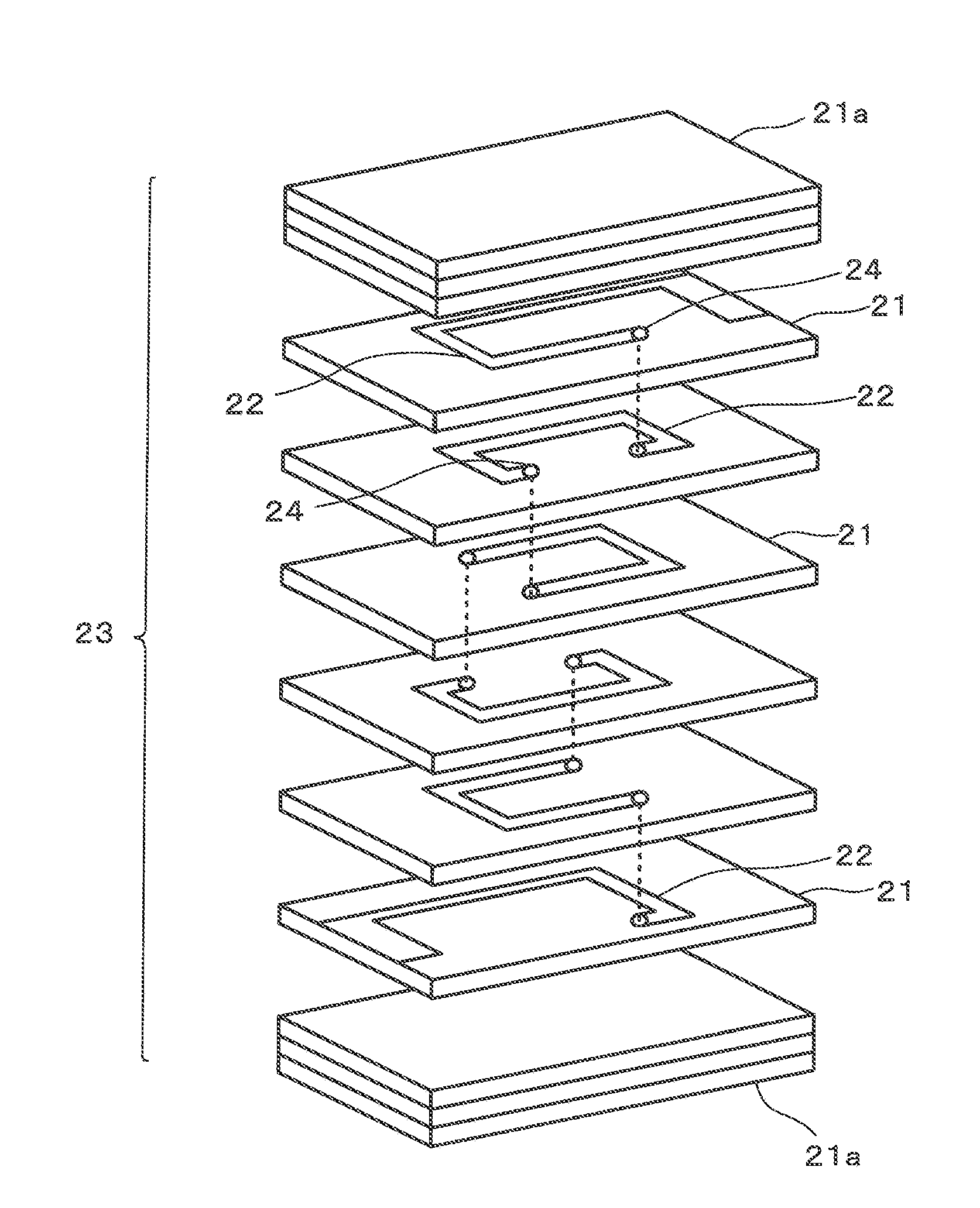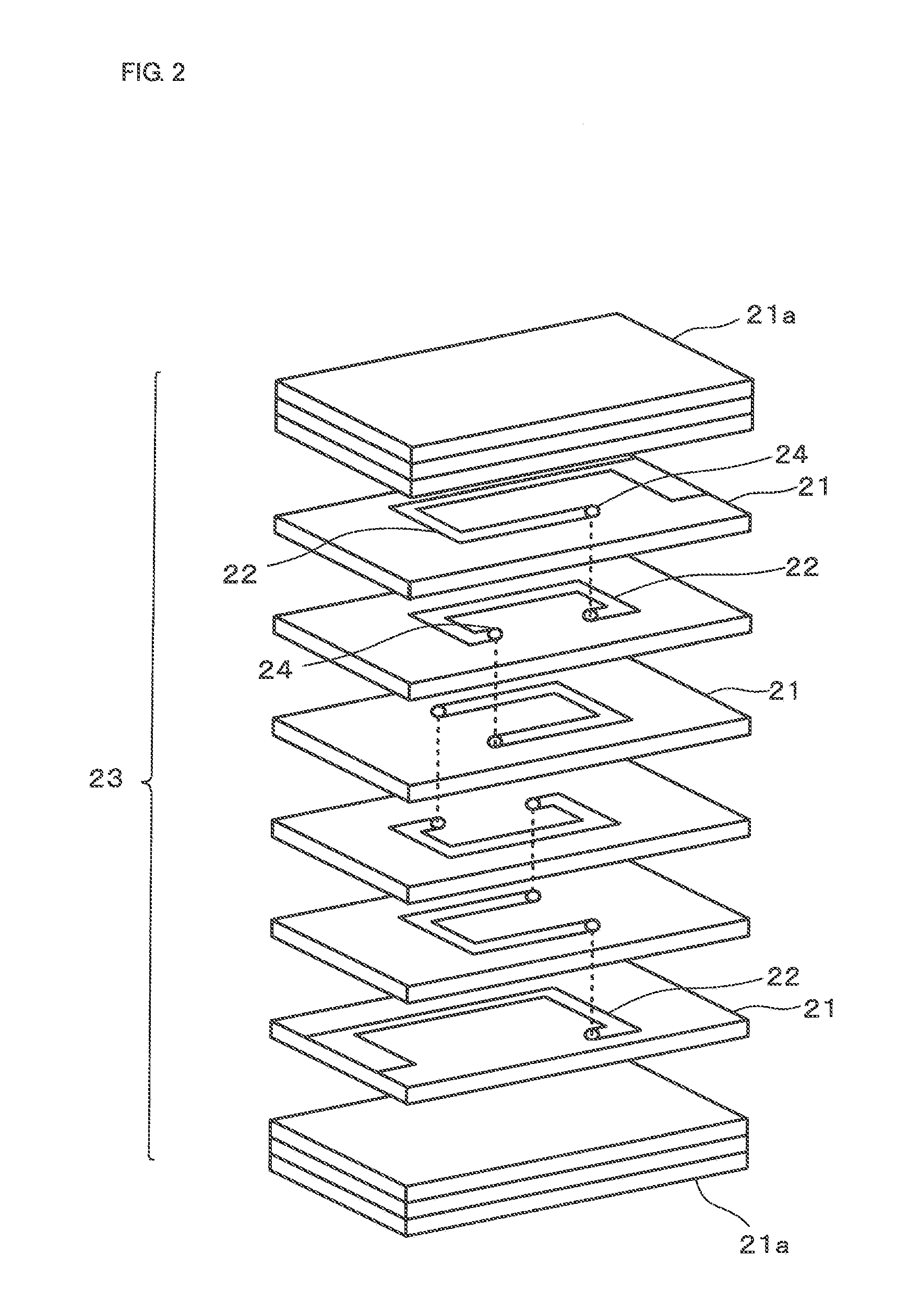Multilayer coil component and method for manufacturing the same
a multi-layer coil and component technology, applied in the direction of inductances, inductances with magnetic cores, basic electric elements, etc., can solve the problems of reducing the thickness of each magnetic ceramic layer, reducing the product having a low direct current resistance, and increasing the cost of manufacturing. , to achieve the effect of reducing the magnetic permeability of the magnetic ceramic, and reducing the cost of manufacturing
- Summary
- Abstract
- Description
- Claims
- Application Information
AI Technical Summary
Benefits of technology
Problems solved by technology
Method used
Image
Examples
example 1
[0040]FIG. 1 is a cross-sectional view showing the structure of a multilayer coil component (e.g., multilayer impedance element in Example 1) according to one example of the present invention, and FIG. 2 is an exploded perspective view showing a manufacturing method of the multilayer coil component. This multilayer coil component 10 is manufactured through a step of firing a laminate 3 in which coil-forming internal conductors 2 primarily composed of Ag and magnetic ceramic layers 1 are laminated to each other, and a magnetic ceramic element 3 includes a spiral coil 4 therein.
[0041]In addition, a pair of external electrodes 5a and 5b is provided at two end portions of the magnetic ceramic element 3 so as to be electrically connected to two end portions 4a and 4b of the spiral coil 4, respectively.
[0042]In addition, in this multilayer coil component 10, as schematically shown in FIG. 1, no voids are present at interfaces A between the internal conductors 2 and a magnetic ceramic 11 l...
example 2
[0113]In Example 2, an example of a multilayer coil component formed using a magnetic ceramic added with a glass will be described.
[0114]A magnetic raw material was prepared in such a way that Fe2O2, ZnO, NiO, and CuO were weighed at a ratio of 48.0 mole percent, 29.5 mole percent, 14.5 mole percent, and 8.0 mole percent, and wet mixing was performed using a ball mill for 48 hours to form a slurry.
[0115]Subsequently, this slurry was dried by a spray dryer and was calcined at 700° C. for 2 hours to obtain a calcined material.
[0116]Next, after a zinc borosilicate-based low softening point crystallized glass was added to this calcined material at a ratio of 0 to 0.6 percent by weight and was then wet-pulverized by a ball mill for 16 hours, a predetermined amount of a binder was mixed, so that a ceramic slurry was obtained.
[0117]In addition, the zinc borosilicate-based low softening point crystallized glass may be added before the calcination.
[0118]The zinc borosilicate-based crystalliz...
example 3
[0137]In Example 3, an example of a multilayer coil component formed using a magnetic ceramic in which SnO2 was added to NiCuZn ferrite will be described.
[0138]After Fe2O3, ZnO, NiO, and CuO were weighed at a ratio of 48.0 mole percent, 29.5 mole percent, 14.5 mole percent, and 8.0 mole percent, SnO was weighed at a ratio of 0 to 1.25 percent by weight to the primary components (that is, at a ratio of 0 to 1.2 percent by weight of the total weight) to form a magnetic raw material, and wet mixing was performed using a ball mill for 48 hours, so that a slurry was formed.
[0139]Subsequently, this slurry was dried by a spray dryer and was calcined at 700° C. for 2 hours to obtain a calcined material.
[0140]After 0.3 percent by weight of a zinc borosilicate-based low softening point crystallized glass was added to this calcined material and was then wet-pulverized by a ball mill for 16 hours, a predetermined amount of a binder was added and mixed, so that a ceramic slurry was obtained.
[014...
PUM
 Login to View More
Login to View More Abstract
Description
Claims
Application Information
 Login to View More
Login to View More - R&D
- Intellectual Property
- Life Sciences
- Materials
- Tech Scout
- Unparalleled Data Quality
- Higher Quality Content
- 60% Fewer Hallucinations
Browse by: Latest US Patents, China's latest patents, Technical Efficacy Thesaurus, Application Domain, Technology Topic, Popular Technical Reports.
© 2025 PatSnap. All rights reserved.Legal|Privacy policy|Modern Slavery Act Transparency Statement|Sitemap|About US| Contact US: help@patsnap.com



